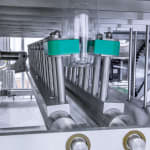
It is often a combination of small things that have a big impact, as is the case when filling sensitive beverages into PET and HDPE bottles. Here, with a whole range of innovations for its system solutions KHS provides greater efficiency, more flexibility, increased ease of operation and optimum product safety.
Mixed milk beverages, juices, smoothies, iced teas and near-water products are in – and the list of sensitive beverages continues to grow. They make high demands of hygienic filling so that the consumer can enjoy them fresh. “When filling and capping beverages so as to prevent recontamination, filling under aseptic conditions especially is a gentle process,” explains Manfred Härtel, filling product manager at KHS. There are hardly any alternatives to this technology. “With over 25 years of experience KHS is a real pioneer and specialist when it comes to hygiene and freshness. This is also demonstrated by the fact that we offer our customers a full range of systems tailored to suit very different requirements.”
KHS technology is always state of the art regarding the task on hand, namely the sterile beverage filling of sensitive products, and continuously ensures the best possible hygienic conditions, as Härtel explains. Nevertheless, KHS is constantly striving to further improve its lines and machines. At the moment, a total of seven optimizations for the modular KHS linear aseptic filler are helping to further boost its efficiency and flexibility in particular. Most machines can be retrofitted with the further developed components.
Variable aseptic block
KHS’ linear aseptic fillers can be blocked with a rotary stretch blow molder – in this case, an InnoPET Blomax V – to form an extremely compact unit. For this purpose, KHS has developed a transfer module that harmonizes the continuous PET bottle flow with the stepped filling process. This is done with the help of a transfer carousel that separates the containers into units of ten. During a brief stop phase these are removed by grippers and placed in the filler’s carrier plates. There are three variants of the module: one for blocking with a stretch blow molder, a second with an additional discharge to a Plasmax coating machine and a third with an extra bottle infeed that enables the filler to process both PET and HDPE bottles.
Optimized bottle infeed
With the number of bottle formats and designs rapidly increasing, systems have to be more and more flexible. Unlike in the past, following a format changeover the bottle infeed is now no longer set up in a repetitive process that involves loosening and fastening screws, running tests and making fine adjustments. Instead, handwheels marked with scales permit the exact height and diameter of a container to be easily configured and ensure that these settings can be reproduced at all times. This reduces the time for format changeovers by up to 40%.
Optional flexible servo capper
Instead of one drive for all ten capping heads, each capping head is equipped with two servodrives apiece. While the first drive lifts and lowers the capper cone, the second drive controls the capping rotation. The servodrives are programmed on the HMI. Automated conversion and the reproducibility associated with this allow different caps to be used, thus increasing flexibility without the operator having to make any manual adjustments. The parameters needed for correct capping of the PET bottles are stored in what are known as cap recipes; each cap used can be individually configured.




